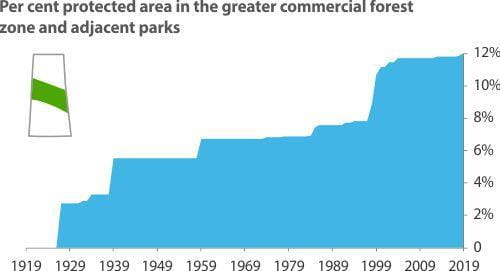
Ecosystem diversity, the variety and relative abundance of ecosystems and their plant and animal communities, is necessary for species preservation. Many ecosystems found throughout Saskatchewan support their own unique range of species. Protecting unique ecosystems, along with those representative of the landscape, helps to maintain biological diversity.
What's happening

What we are doing
The province of Saskatchewan covers an area of approximately 65.2 million hectares. Of this, nine per cent is under some form of ecological protection under the Saskatchewan Conserved and Protected Areas Network (PCAN) program. Protected areas represent different landscapes which have been set aside to preserve natural or cultural features. Protected areas can also serve as benchmarks for the ministry to monitor the impact of human activities and their effect on the environment. The selection of natural areas is largely based on soil and vegetation, as well as unique features such as bogs, land formations and species habitats. The goal of PCAN is to preserve ecologically important land and aquatic areas across the province. The target for the program is to have 12 per cent of the province protected.
Four ecozones are found within the province: Taiga Shield, Boreal Shield, Boreal Plain and Prairie. The provincial forest covers approximately 34 million hectares within the Taiga Shield, Boreal Shield and Boreal Plain ecozones.
Like the province as a whole, nine per cent of the provincial forest is protected. At the ecozone level, 13 per cent of the Taiga Shield, six per cent of the Boreal Shield, and 12 per cent of the Boreal Plain ecozones within the provincial forest are protected. Upland forests account for 62 per cent of protected areas in the provincial forest (32 per cent softwood, 13 per cent mixedwood, 9 per cent hardwood, and 8 per cent open productive/shrub forest types). Wetlands and water account for 18 per cent and 17 per cent of the provincial forest's protected areas, respectively. Grass, agricultural, barren rock / sand, anthropogenic and other areas make up the remaining 3 per cent of the landcover.

For the purposes of this indicator, the 11.7 million ha commercial forest zone has been expanded to include the Cold Lake Air Weapons Range, and provincial and national parks within and adjacent to the commercial forest zone. Within the provincial forest, the greatest amount of human activity occurs within this 14.3 million-hectare area referred to as the greater commercial forest zone. Protected areas within and adjacent to the greater commercial forest zone account for 12 per cent of its area.
Over half of protected areas within the greater commercial forest zone are upland forests, nearly evenly split between softwood (20 per cent), mixedwood (17 per cent) and hardwood (15 per cent) forest types. Wetlands also feature prominently within greater commercial forest zone protected areas, covering over a quarter of the area.


Over the last century, lands designated as protected in Saskatchewan's provincial forest and in the province as a whole have increased gradually to their current nine per cent level. While this current state is less than the 12 per cent provincial protection target, the trend continues to move in a positive direction. Between 2000 and 2009, areas protected in Saskatchewan increased by 710,000 ha to 5.68 million hectares. Over the last 10 years (2010-2019), an additional 470,000 hectares have been placed under protection in Saskatchewan, for a total of 6.15 million hectares.
Within the greater commercial forest zone, where the majority of forest-based economic activity occurs, the 12 per cent protection target is achieved. As this zone is where forest land use pressures are highest, protection is of greatest importance. Current land use pressures in the portion of the provincial forest north of the greater commercial forest zone are relatively minor, suggesting that the majority of this landscape is in a natural state. The relative lack of forest land use pressures in this portion of the provincial forest suggests that the functional area protected is greater than the nine per cent with official protection designations. However, with continued interest in development, there may soon be a need to establish more protected areas in Saskatchewan's northern provincial forest.



Why it matters
Protecting portions of Saskatchewan's land helps maintain the natural range of ecosystems, helps sustain biological diversity and results in a more resilient system. The protection of unique and representative ecosystems sustains habitat for fish, wildlife, plants and people while supporting recreation and economic opportunities for the future.
Protected natural areas may protect species at risk or preserve areas with unique physical features such as waterfalls, badlands or sand dunes. Management of protected areas allows for appropriate recreational, educational and research opportunities while minimizing damage for the future.
More detailed information can be found in this technical report.








